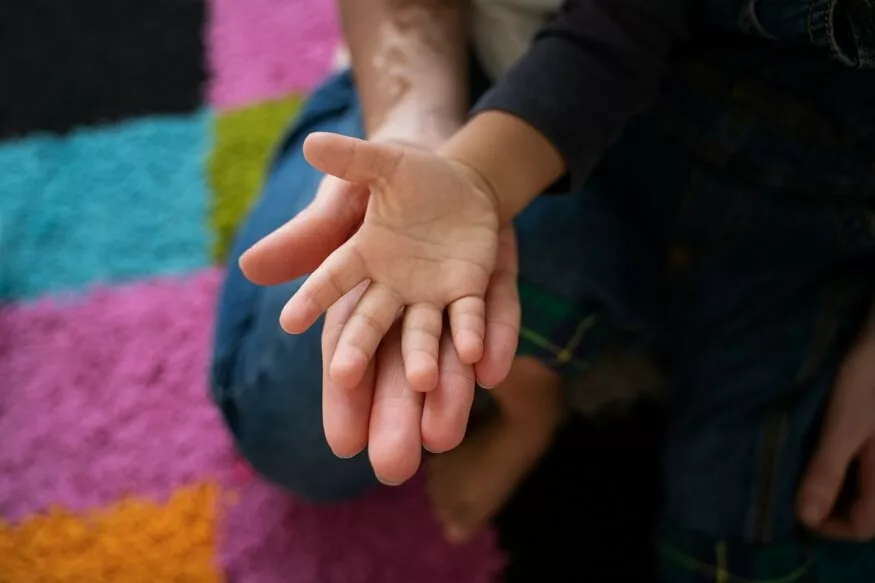Educating children about the distinction between appropriate and inappropriate touch is of utmost importance to ensure their safety and emotional well-being. The concept of ‘good touch and bad touch’ provides a foundational understanding for children, enabling them to recognise when they might be in uncomfortable or harmful situations. As children grow, the way in which this topic is approached must evolve in tandem with their cognitive and emotional development. Here’s a guide on how to teach ‘good touch and bad touch’ to different age groups of 3-5, 5-10, and 10-13.
Also Read: Knowing when and how to say “no”
1. Ages 3-5
At this age, children are naturally curious about their bodies and the world around them. Simplicity is the key when teaching them about good touch and bad touch.
- Use simple language:
- Introduce the swimsuit rule:
- Role-play with toys:
- Emphasise the importance of feelings:
- Teach them to say ‘no’:
Talk about ‘safe’ and ‘unsafe’ touches. Explain that a good touch makes them feel happy, like a hug from a family member, while a bad touch might make them feel uncomfortable or scared.
Tell children that the areas covered by a swimsuit are private. No one should touch those areas except in specific circumstances, like when a doctor is checking them with a parent present or during bath time.
Use dolls or action figures to show examples of good touch and bad touch. This provides a visual representation, making it easier for children to understand.
Let them know it’s essential to trust their feelings. If a touch feels wrong or makes them uneasy, they should tell a trusted adult.
It’s important for kids to understand that they have the right to refuse any touch that makes them uncomfortable, even from familiar people.
Also Read: How to Improve Problem Solving Skills in a Student?
2. Ages 5-10
Children in this age bracket begin to understand more about personal boundaries. They’re also likely to engage in more social interactions outside the home, making it crucial to delve deeper into the good touch and bad touch concept.
- Continue with the swimsuit rule:
- Use stories and scenarios:
- Address peer interactions:
- Discuss secrets:
- Teach them to find trusted adults:
Reiterate the private parts’ concept, but also emphasise that any touch, even outside these areas, that makes them uncomfortable can be considered a bad touch.
Create hypothetical situations or use age-appropriate books that deal with the topic. Discuss the scenarios with your child, asking questions like, “How do you think the character felt? Was that a good touch or a bad touch?”
At this age, kids might experience inappropriate touching from their peers. Make sure they understand that even if it’s a friend, bad touch is still bad touch.
Explain the difference between good secrets, like surprise parties, and bad secrets, which might make them feel uneasy or anxious. Tell them never to keep secrets about touches.
Emphasise the importance of talking to a trusted adult if they ever experience or witness inappropriate touching.
Also Read: Everything about Active Listening & Its Importance
3. Ages 10-13
As children approach adolescence, they become more aware of their bodies and may start experiencing a range of emotions. The conversation around good touch and bad touch should mature to address their developing needs.
- Discuss the changing body:
- Address peer pressure:
- Talk about online safety:
- Encourage open dialogue:
- Discuss consent:
As puberty begins, kids may feel self-conscious about their bodies. Reassure them that these changes are natural and that respecting personal boundaries is still crucial.
At this age, peer interactions can sometimes involve challenges or dares. It’s vital for them to know that they should never feel pressured into touching someone or being touched, even if it’s framed as a ‘joke’.
As many kids become more active online, discuss the dangers of sharing personal photos or information. Reiterate the principles of good touch and bad touch in a virtual context.
Make sure they know they can come to you with any concerns. The lines of communication should always remain open, fostering a safe environment for them to share.
Introduce the concept of consent, explaining that both parties should feel comfortable and agreeable in any touching scenario, and that it’s always okay to change one’s mind.
Also Read: Sensitive Parenting in the Digital Age: Navigating Technology with Care
Importance of teaching good touch and bad touch
Here’s why such teaching good touch and bad touch is important:
- Child Empowerment:
- Facilitating Early Detection:
- Bolstering Emotional Resilience:
- Building Trust:
- Establishing a Precedent for Future Interactions:
- Breaking Taboos:
- Promotion of Healthy Relationships:
Above all, educating children on this topic bestows upon them a sense of empowerment. They grasp the essential truth that their bodies belong to them alone. This understanding gives them the confidence to assertively voice discomfort or decline a touch, no matter who the instigator might be.
Unfortunately, the perils of inappropriate touch are often veiled in secrecy. By arming children with knowledge about what constitutes ‘bad touch’, they can identify and, crucially, communicate any inappropriate behaviour they might encounter, allowing for timely interventions.
Encountering a ‘bad touch’ can be emotionally traumatising. By distinguishing between good and bad touch from an early age, children can better contextualise such experiences, reducing feelings of guilt, confusion, or self-blame. This understanding aids in building their emotional resilience.
Open conversations about touch foster a foundation of trust between children and caregivers. Such discussions reassure children that they are in a safe environment where their feelings and experiences will be acknowledged and addressed.
The principles of consent and boundaries, once instilled at a young age, remain lifelong guides. By understanding these principles early on, children are better equipped to navigate relationships and encounters throughout their lives, ensuring their well-being and fostering mutual respect in their interactions.
In many societies, topics related to the body and physical intimacy can be taboo. By broaching the subject of good touch and bad touch, we begin to dismantle these taboos, creating an environment where open dialogue is encouraged and misconceptions can be rectified.
Knowledge of good touch and bad touch isn’t just about immediate protection; it sets the stage for healthy relationships in the future. As children mature into adults, this early education ensures they understand the importance of mutual respect, consent, and communication in all interactions.
We at EuroSchool teach children about good touch and bad touch. At our school, we start with simple concepts for younger kids and gradually introduce more complex ideas as they grow to ensure they have the tools to protect themselves and understand their personal boundaries.










